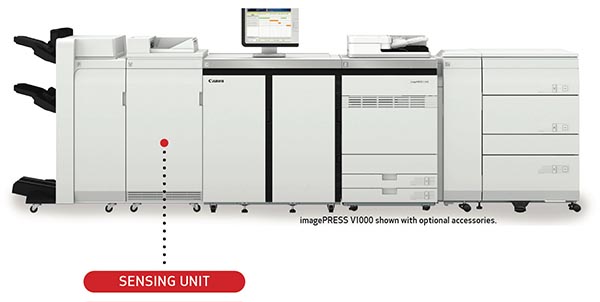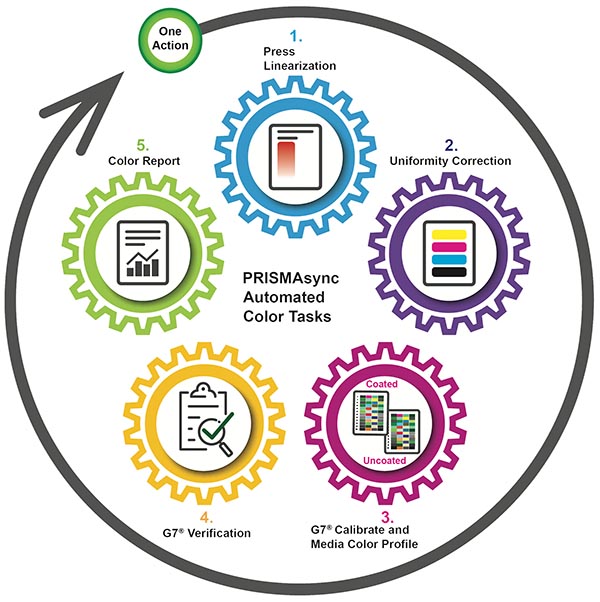
This article is sponsored by Canon as part of WhatTheyThink’s Print Software Product Spotlight series. In preparing this article, the WhatTheyThink Print Software Section editors conducted original, in-depth research on Canon’s Press Automation Modules. This Product Spotlight describes what the editors feel are the product’s strengths in the marketplace. Canon reviewed the final article for accuracy but had no editorial control over the content.
With the aging out of skilled labor in the print and packaging industry, engaging and training new hires in the intricacies of print is becoming a problem. Press automation modules can simplify the process while optimizing quality and productivity for new and even older digital presses.
Background
No matter what printing and production technology you are using, the fact is that the skilled operators are going to age out sooner or later. Engaging new hires and learning those inherent skills can take years, and considering that the technologies are evolving and changing they are a moving target for training new operators. Furthermore, as consumer requirements continue to move to shorter run lengths, the need for automation is essential.
To address these issues, we are seeing a move toward more digitalization of production equipment, including automated machine controls and even machine learning. While this digitalization is built in for some of the newer systems, it is also being offered as an upgrade module for some of the late model equipment. This digitalization is usually targeted at reducing the amount of manual routine tasks while improving quality and production efficiency.
Advanced Automation Modules
One of the newer methods of incorporating optional advanced automation into digital presses is through use of inline quality control systems. A great example of this is the new Canon imagePRESS Sensing Unit.
This optional unit can be integrated into a range of imagePRESS color digital presses including the V1000, C10010VP, C9010VP and the C910, C810 and C710. This accessory is designed to address Front-to Back Alignment and Registration, Cross-Shade Adjustment (color uniformity across the sheet), Color Accuracy (consistency throughout the run) and Secondary Transfer (optimizing toner transfer on different medias) prior to printing.
In addition the Sensing Unit can measure and make any necessary adjustments of Front-to Back Alignment, Registration and Color Accuracy in real time on the fly during the run. Without the Sensing Unit the press make-ready adjustments requires operator intervention and importantly time.
Color
Many digital presses, including the Canon imagePRESS measure color bars off the transfer belt to make sure densities are consistent, however that doesn’t take into account the effect of the media. Most digital press operators do their initial testing at the start of the day or maybe the beginning of the week. The problem is the environmental conditions may change during the day and could have an impact on the print quality.
With the imagePRESS Sensing Unit, the operator can have it check and adjust the color before the run and during the production printing run. The Sensing Unit and press does all the work for them. If you can place the 32 patch color bar target on the sheet, it will measure every sheet, if you don’t have room for color bars, you can set the system so that it does a check after a user definable number of sheets. It will print a sheet with just the test targets and automatically send the sheet to the Sensing Unit purge tray so it does not interfere with printed job. In either case the system adjusts the press on the fly when needed in real time so it doesn’t impact productivity.
In the case of the Canon imagePRESS V1000 and imagePRESS C10010VP Series, there is also internal Inline Spectrophotometers (ILS), and if you have the PRISMAsync print server, the printer calibrations steps such linearization, G7® calibration, color profiling and even verification can be automated and completed in a matter of minutes with minimal operator intervention.

Registration
Registration can be critical on printed materials. With cut sheet media, there can, and usually is, some variability in size. Many of the newer digital printers like the imagePRESS V1000 can duplex up to a 400 GSM sheet and are now supporting 51-in. media up to 300 GSM duplex, so paper alignment and skewing can present problems with front to back registration. Add to that the difficulty and quality of currently available papers an operator can use a lot of time and waste on ensuring that the registration is within tolerance.
The Sensing Unit can check and adjust the Front-to Back Alignment and Registration for a job in less than a minute to make sure the registration is within tolerance before you start production. Very much like with the color checking it can be set to check registration on every sheet or at a predetermined number of sheets.
More Productivity and Less Waste
Integrating automation module technologies like the Sensing Unit can help operators of all skills reduce the time needed to manually test, monitor and adjust color and registration on a digital press. By installing it on a new or existing supported imagePRESS you can help achieve predictability and higher quality and productivity.
Brad Steven, IT Manager at Print-Tech in Ann Arbor, Mich., said, “When we are looking at new purchases, it’s not only quality, but can we gain some efficiencies so I can get things off the machine quicker or out the door faster. In looking at a new C10010 we decided to add the cooling and sensing units on the two new presses. What pushed us over the edge to spend the money to add upgrades to the two machines was time savings. I can now produce more jobs in a day more efficiently, but the quality also is there, because of the real time checking of the color quality and adjusting on the fly. It’s real money savings in the long run.”














